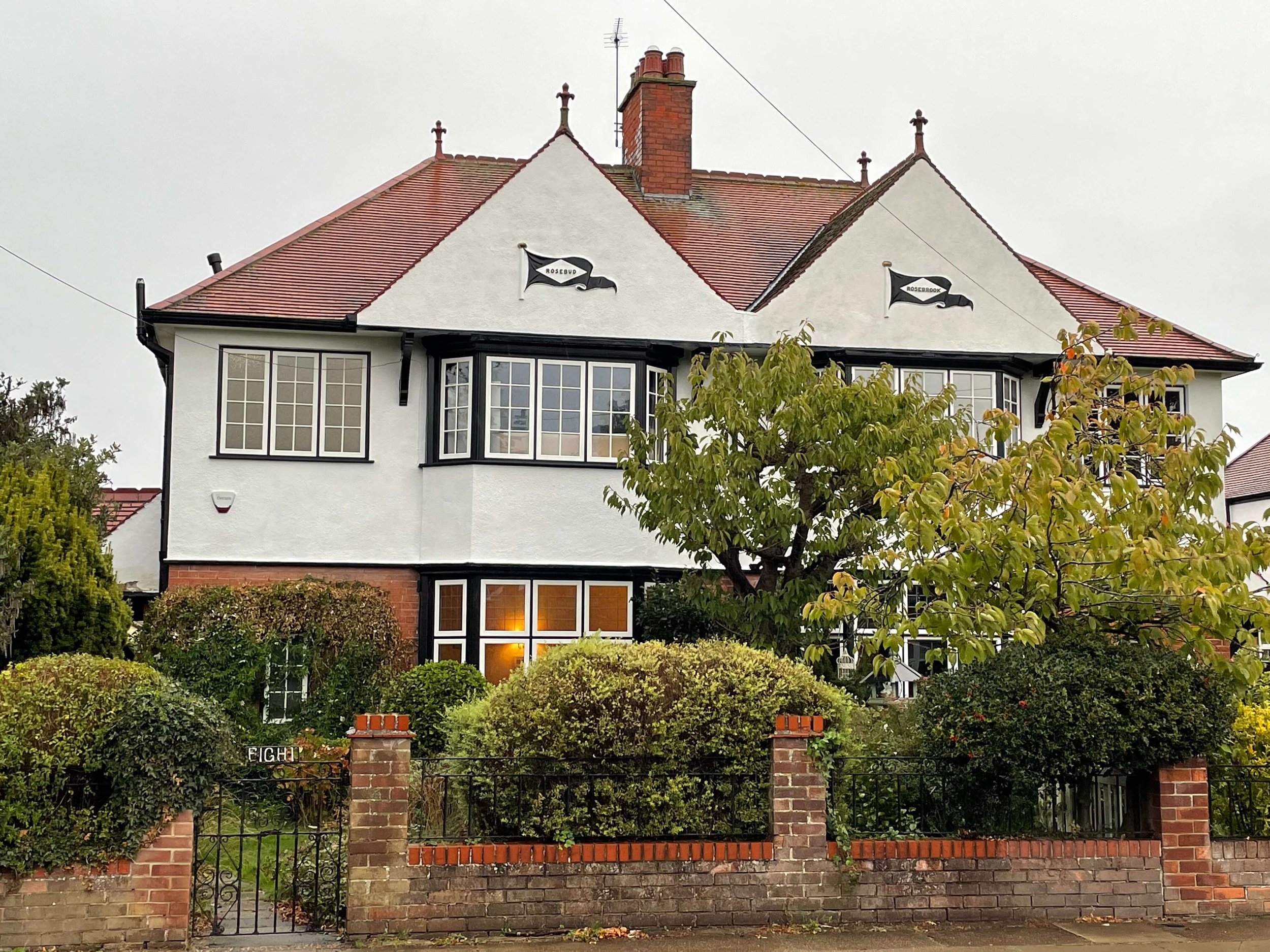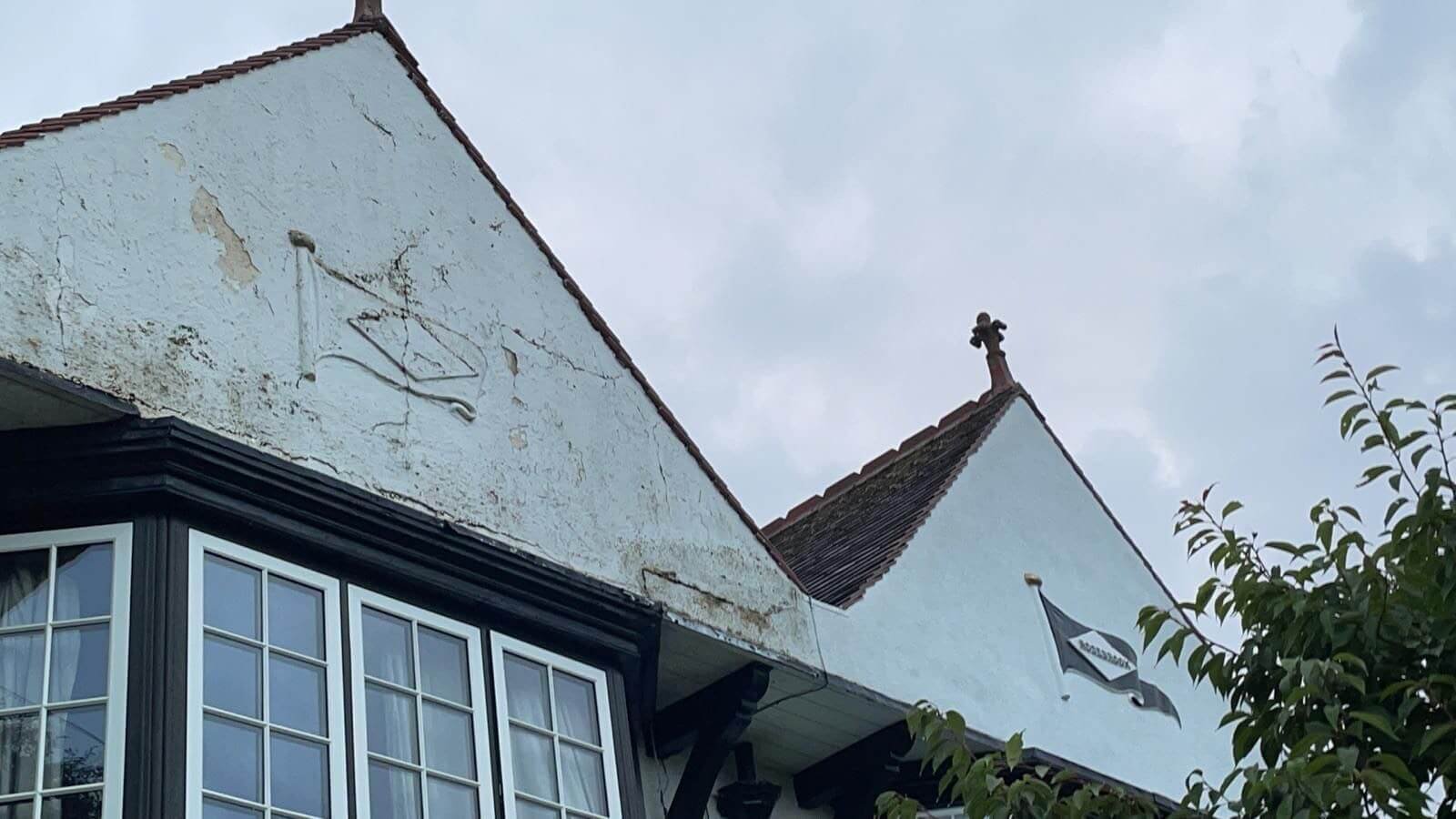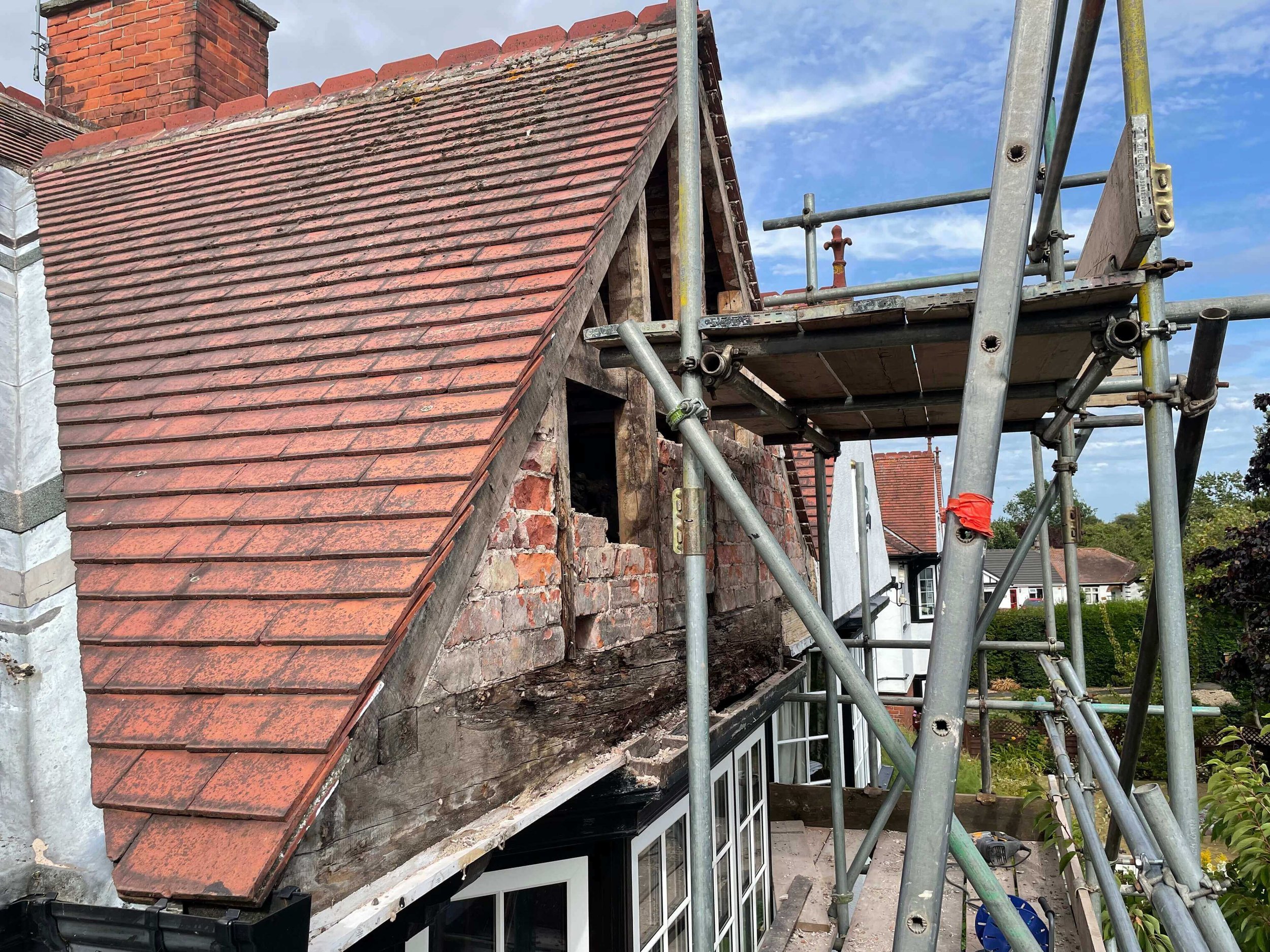Fairfield Road Flag House Restoration
The Flag Houses on Fairfield Road, Scartho are locally iconic and were built in around 1910 for Thomas Baskcomb’s company The Louvre Limited. Referred to locally as the Flag Houses, their gables are decorated with a cement flag, incorporating the house name.
Photo credit: Benjamin Wood
Each house has a ‘gable stone’ with an ornate flag moulding with the house name in the centre. The names all begin with ‘Rose[…]’ being built on land that had been part of Rose Farm (the old farm house is next door).
We were contacted by the owner of the property at Rosebud, Fairfield Road to repair and restore the Flag House to its former glory. The flag had been badly damaged before the previous occupier purchased the property in the 70s - the name was no longer visible.
Ben, the owner told us that he felt “restoring this feature has therefore felt a historically important moment.”
What We Did
Rosebud is an Edwardian semi-detached property, the Flag House was in the process of being decorated internally when the owner noticed wet rot, with the main joist and gable end rotten. The timber needed replacing and the gable re-rendering.
Having worked on a project for the owner previously, he contacted us with the knowledge that we had undertaken a similar project on the Flag Houses, Weelsby Road. After an initial survey with the client, discussing the project and what they wanted to achieve, and the relevant structural checks made, we were commissioned to reinstate the flag motif on the house as part of this restoration project.
You can see from the image below the damage to the property and the flag, compared to the neighbours flag and rendering.
Photo credit: Benjamin Wood
Restoration and Repair Process
Flag
The flag restoration process started with the flag being taken down, (this ideally needs to be in one piece, and thankfully in this case it was).
Photo credit: Benjamin Wood
During this process a template of the flag was taken from one of the neighbours houses, to be used as a base for the replacement flag. This is done by tracing the existing flag to allow us to get an overview template design of a flag that was in good condition.
From the tracing template, we then were able to make a timber template to get the basic shape to the flag.
The drawing was sent to Saffron Mouldings, a clay artist who started the clay modelling process, using timber boards before applying clay and creating the flag detailing and lettering (using stencils for precision).
Saffron Mouldings then created the clay model and made the lettering detail (the wording was created by printing the name in the chosen font and cutting this out using tools), transferring it into clay.
The completed clay piece was modelled and a silicone rubber mould was then made, this is called a reverse mould. The reverse mould was then sent to us to make a cast out of it, which allowed us to see what the finished product was going to look like.
Once the mould was ready, the correct resource was poured into the mould, in this case glass reinforced cement, but it can be made from anything, depending on what the project requires. A fresh cast was then taken, making sure there were no air bubbles! The detailing at this point looked amazing and the flag was ready for installation.
Once the flag had been created, and the gable restored (see details below) a framework was built and we fixed the flag to this with the suitable fixings. This then allowed the rendering to be complete all around it. The flag was then painted by Jonathan, who has completed the painting of flag on previous projects.
Gable End
As part of the overall restoration project, the gable was rebuilt, freshly rendered and painted to complete the Edwardian look and feel of the house, with the replacement flag adding the final finishing touch.
Results
Ben, the owner of the property is really pleased with the results of the project and commented:
“As I’ve come to expect from Ryan, the quality of the workmanship has been outstanding. Ryan is clearly passionate about his work - the quality is outstanding, his knowledge is expert and his work ethic unquestionable. To compliment the craftsmanship of the moulding, the flag was then painted with great care and attention to detail by my neighbour Jonathan. He decorated the knob at the top of the pole in gold leaf. The result is outstanding - I am over the moon.”
We are really happy with this project and the outcome, it was a great project to be part of. The Flag House looks amazing, with the Edwardian features rightly restored and looking their very best!
Photo credit: Benjamin Wood
Old House, First Love
Old houses – where do we begin? A romance that is utterly unique, and in every sense of the word too. When you decide to buy an old house, the honeymoon stage fleeting replaced by a complicated but hearty relationship which, with every milestone, grows more complicated. It can feel like the house takes more than it gives at times. It can feel rather, off-kilter. There will be highs, and there will inevitably be lows but, somehow, through it all, that twinkle never seems to dull.
Benefits of investing in an old home
Investing and living in an old home, is not for everyone. In fact, we’d go as far to say that for a lot of people, they just aren’t an attractive prospect. To some it is the shine, the simplicity, the youth of new properties that drives a sale. And that’s totally fine - each to their own.
When you choose an older property, you may not get clean lines, you may not even get straight walls, you may not – and in our experience probably won’t – get a smooth ride during the refurbishment stages, but what you will get is worth its weight in gold. What you get is an experience, an adventure even.
In return for your perseverance, your dogeared determination and persistence for doing things ‘right’, you will get a true one-off. You will be moving into living history. You will have a home with heart, memories, character, stubbornness, and one that has been brought back to life with a shedload of surprises along the way. If you’re one of those people who has a soft spot for heritage, for things there were made with dedication, attention to detail, respect for the old ways, then nurturing an old building will absolutely be for you.
A space in a house’s history is one you will have to earn though. When you do get those stripes though, the benefits you reap will absolutely outweigh your efforts. You’ll have a one-off home, a unique backdrop, one that you created, ready for you to create your own cherished memories in. Far from only delivering sentimental satisfaction, financially, the monetary value you add to a property of age will – in most cases – overtake your initial outlay.
Challenges of an old home
It sounds like it’s all sunshine and rainbows, but there are of course lows. And believe us there will probably be plenty. Like any renovation project, it isn’t always smooth sailing, but older houses do seem to come with their own agendas, their own attitude. We’ve seen projects sail through with barely a hiccup and then we’ve seen ones that encounter issue after issue. From finding dry rot or subsidence, to unearthing drainage problems, damp, even structural instability - not ruling out any cowboys who may have come before you too.
You will face challenges along the way. For most, these boil down to financial and material. As we’ve said, what you put in, in most cases, isn’t wasted investment, but with older properties unless the correct initial surveys and research are undertaken by proven professionals, some buyers can find themselves unexpectedly on top of a money pit. As for materials, prices may have increased on your standard supplies, but when it comes to working in Victorian or Edwardian homes for example, even medieval ones, replacing like-for-like does require time, and effort. Finding the resources you need can be a tricky task. That said, it can also be a rather enjoyable one. Trawling salvage yards, haggling over specific pieces such as coping stones, flagstone floors or fireplaces, finding experts who can repair or recreate damaged original features – plaster ceiling details or coving for example – requires more of that drive and dedication we’ve already talked about. It requires passion.
Old buildings and their refurbishment are not for the faint of heart. They can be all-consuming. They can have you banging your head against a very old brick wall one minute, the dancing on the ceiling the next. We’ve gone on about the lows, but there are so many highs too – and these will be the moments you remember. They can be as simple as pulling back a stained old carpet to find beautifully preserved floorboards, or original tiles lining your hallway. They can be as small, yet deliciously delightful, as uncovering antique spoons hidden under floorboards, or lost marbles behind a skirting from a long unfinished game. Hints of plasterwork, cornicing, corbels and ceiling roses, even hand-painted wallpaper, that have been patiently waiting for their next time to shine.
There’s never a dull moment when restoring an old home
Then, there are the moments that don’t fall into either category. The surprising, unnerving moments. Finding bricked-in knick-knacks that do make you ponder the previous owners reasoning for hiding them in the first place, or bird skeletons choosing the optimum time to drop out of chimney breasts. Children’s shoes dug out of tile floors laid straight onto mud.
There is never a dull moment when an old home is being restored. We use that word specifically because that is exactly what you are doing when you take on an old house. In fact, when you buy an old home and make it your own, you don’t really become the new owner, you take on the role of custodian. Because, really, that is what you are. You may hold the keys, but you are one in a long line of people who have cared for that house.
New homes may have their appeal, but old homes, have grandeur. They have nostalgia. They have mystery and pull at our curiosity. They have some sort of draw that we can only compare to finding buried treasure. To us, that is what heritage homes are, treasure. Not buried, but right on the surface of things, just waiting for someone to turn the key, open the door, and breathe life back into their gilded edges once more.
























